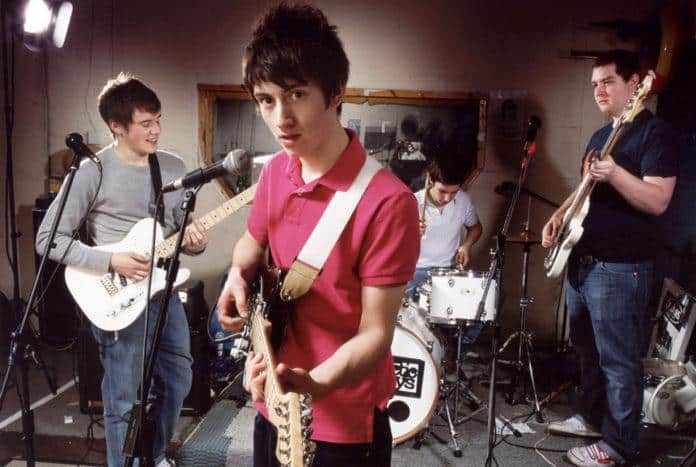Arctic Monkeys, the iconic British rock band, has captivated audiences worldwide with their distinctive sound.
However, pinpointing the exact genre they belong to can be a challenge, as their music has evolved significantly over the years.
In this blog post, we’ll explore the various musical styles Arctic Monkeys have dabbled in and uncover the genres that best define their sound.
By the end, you’ll understand what makes Arctic Monkeys stand out in the music industry and why their genre-bending approach has succeeded.
So, let’s dive in and discover the musical journey of one of the most influential bands of the 21st century.
Early Years and Initial Genre

1. Formation and Early Music
The Arctic Monkeys began their musical journey in 2002 in Sheffield, England.
Alex Turner, Jamie Cook, Matt Helders, and Andy Nicholson formed the band’s original lineup, with Turner and Helders being close friends and neighbors and Nicholson joining them from secondary school.
Cook later completed the quartet as a second guitarist.
The band drew inspiration from indie and garage rock in the early days, crafting a raw and energetic sound that captured their youthful spirit.
They started rehearsing at Yellow Arch Studios.
They quickly gained a loyal following by handing out demos at their shows, showcasing their early potential, and setting the stage for their future success.
2. Debut Album Impact
In 2006, Arctic Monkeys released their groundbreaking debut album, “Whatever People Say I Am, That’s What I’m Not,” which shattered records by becoming the fastest-selling debut album in UK chart history.
The album firmly established the band’s place in the indie rock, garage rock revival, and post-punk revival genres, thanks to its sharp lyrics and authentic portrayal of British youth culture.
Critics praised the album, recognizing the band’s unique voice and immense talent.
“Whatever People Say I Am, That’s What I’m Not” won prestigious awards, including the Mercury Prize and several Brit Awards, cementing Arctic Monkeys’ status as one of the most exciting new bands of the era.
The album’s success profoundly impacted the British music scene, sparking a resurgence of indie rock and inspiring countless other artists to follow in their footsteps.
Evolution of their Music

Evolution of Sound Arctic Monkeys have become synonymous with their ever-evolving musical style, which has been a key factor in keeping their sound fresh and their fans engaged.
From their humble beginnings in the indie rock scene, the band has fearlessly explored new genres and incorporated diverse influences into their music, resulting in a dynamic and eclectic discography that showcases their growth and versatility as artists.
1. “Favourite Worst Nightmare” (2007)
Following the groundbreaking success of their debut album, Arctic Monkeys released “Favourite Worst Nightmare” in 2007, which largely maintained the band’s indie rock roots and post-punk revival sound.
However, this sophomore effort also introduced more aggressive and up-tempo tracks, such as “Brianstorm,” “Fluorescent Adolescent,” and “Teddy Picker,” adding a new dimension to their music.
The album received widespread critical acclaim and further solidified Arctic Monkeys’ position as one of the industry’s most exciting and influential bands.
2. Humbug Era (2009)
In 2009, Arctic Monkeys took a bold step in their musical evolution by releasing “Humbug.”
This album significantly departed from their earlier sound, as the band embraced psychedelic rock, hard rock, and stoner rock influences.
The collaboration with producer Josh Homme of Queens of the Stone Age brought a darker, more mature tone to the album, characterized by complex, moody atmospheres and heavier guitar riffs.
Standout tracks like “Crying Lightning,” “Cornerstone,” and “My Propeller” showcased the band’s willingness to explore new musical directions.
While some fans embraced this change, others missed the raw energy of their earlier work, resulting in a mixed reception for the album.
3. Impact on the Band’s Career
The evolution of Arctic Monkeys’ sound during this period was a testament to their maturity and growth as musicians.
By experimenting with new genres and styles, they attracted new listeners and challenged their existing fanbase to expand their musical horizons and appreciate the band’s artistic development.
This period laid the foundation for future albums, including the critically acclaimed “AM” and the stylistically diverse “Tranquility Base Hotel & Casino,” cementing Arctic Monkeys’ status as one of their generation’s most innovative and influential bands.
Arctic Monkeys’ evolution from the aggressive, up-tempo sounds of “Favourite Worst Nightmare” to the psychedelic, hard rock-infused “Humbug” reflects the band’s dynamic and fearless approach to making music.
Their ongoing exploration of new genres and willingness to push their sound’s boundaries ensures that their music remains fresh, innovative, and captivating for audiences worldwide, solidifying their position as true icons of modern rock music.
Diverse Influences and Experimentation
1. Suck It and See
“Suck It and See,” released in 2011, represents a pivotal moment in Arctic Monkeys’ musical evolution, showcasing their ability to blend various styles and influences seamlessly.
The album is a testament to the band’s growing musical maturity and willingness to experiment with new sounds.
By combining elements of indie rock, indie pop, and psychedelic pop, “Suck It and See” presents a more diverse and refined sound compared to the band’s previous works, highlighting their growth as musicians.
Notable tracks like “Don’t Sit Down ‘Cause I’ve Moved Your Chair” and “Black Treacle” exemplify the band’s new direction, offering a fresh perspective on their signature style.
To achieve this cohesive yet varied collection of songs, Arctic Monkeys dedicated significant time to writing and rehearsing extensively before recording the album.
The influence of British rock bands from the 1960s can be heard throughout the record, along with the incorporation of love-themed ballads, adding a new dimension to their music and demonstrating their versatility as songwriters.
2. AM
“AM,” released in 2013, stands as one of Arctic Monkeys’ most successful and innovative albums.
It effortlessly blends multiple genres to create a captivating and unique sound.
The album masterfully fuses elements of psychedelic rock, blues rock, and hip-hop influences, resulting in a dynamic and engaging listening experience.
Standout tracks like “Do I Wanna Know?” which became a global hit, perfectly encapsulate the album’s innovative approach, combining rock sensibilities with hip-hop beats to create a fresh and exciting sound.
“AM” also marks a shift in Arctic Monkeys’ songwriting, presenting a more mature and reflective approach to crafting lyrics and producing music.
Critics praised the album for its lyrical depth and musical complexity, highlighting the dark and seductive atmosphere that permeates throughout the record.
The album’s success significantly impacted Arctic Monkeys’ career, garnering both commercial success and critical acclaim.
Collaborations with artists like Josh Homme from Queens of the Stone Age further contributed to the album’s distinct sound, showcasing the band’s openness to working with other talented musicians to push their creative boundaries.
“Suck It and See” and “AM” serve as prime examples of Arctic Monkeys’ diverse influences and their willingness to experiment with different musical styles.
These albums showcase the band’s growth and maturity as musicians and highlight their ability to incorporate a wide range of genres into their music successfully.
The significance of these albums in Arctic Monkeys’ discography cannot be overstated, as they have contributed to the band’s lasting impact on the music industry and solidified their status as one of the most innovative and influential rock bands of their generation.
Recent Musical Directions
In recent years, Arctic Monkeys have undergone significant shifts in their musical style, showcasing their willingness to experiment and explore new genres.
These changes have kept their music fresh and exciting, demonstrating their growth and maturity as artists.
1. Tranquility Base Hotel & Casino
Released in 2018, “Tranquility Base Hotel & Casino” marked a major departure from Arctic Monkeys’ previous guitar-heavy sound, instead opting for a more piano-oriented approach.
The album introduced lounge pop, space pop, and glam rock elements, creating a unique and captivating atmosphere.
The focus on piano-based compositions is evident in tracks like “Four Out of Five” and the title track “Tranquility Base Hotel & Casino,” which showcase the band’s ability to craft intricate and engaging melodies.
While the album’s sudden shift in style polarized some listeners, it received overall positive reviews from critics, who praised the band’s bold and innovative direction.
2. The Car
Arctic Monkeys continued their exploration of new musical landscapes with the release of “The Car” in 2022.
The album seamlessly blends various genres, including art rock, orchestral rock, and lounge pop, creating a cohesive and enthralling listening experience.
Tracks like “There’d Better Be a Mirrorball” and “Body Paint” exemplify the album’s diverse sound, combining lush orchestration with the band’s signature storytelling and introspective lyrics.
“The Car” was met with critical acclaim, with many reviewers praising the band’s ability to push the boundaries of their music while maintaining their distinctive style.
Arctic Monkeys’ recent musical directions, as showcased in “Tranquility Base Hotel & Casino” and “The Car,” have highlighted the band’s continuous evolution and solidified their position as one of the music industry’s most innovative and influential acts.
By embracing new genres and styles, the band has proven its ability to adapt and grow, keeping its music fresh and relevant.
As fans eagerly anticipate Arctic Monkeys’ future projects, it is clear that the band will continue to push the limits of their creativity, exploring new directions and cementing their legacy as true pioneers of modern rock music.
Conclusion
Arctic Monkeys have proven to be one of the most versatile and exciting bands of the 21st century.
From their early days as indie rock upstarts to their recent explorations of lounge pop and orchestral rock, the band has consistently pushed the boundaries of its sound while maintaining a distinctive style unmistakably its own.
As we look to the future, it’s clear that Arctic Monkeys will continue to evolve and surprise us with each new release.
Whether you’re a die-hard fan or a casual listener, this band has profoundly impacted the music world.
So, what’s next for you?
Dive into their discography, catch them live on tour, and join the millions of fans captivated by the music of Arctic Monkeys.
Frequently Asked Questions
What Genres Of Music Are Arctic Monkeys Known For?
Indie rock, garage rock, post-punk revival, psychedelic rock, alternative rock, and lounge pop.
How Has The Musical Style Of Arctic Monkeys Evolved Over The Years?
From raw indie rock to exploring psychedelic, hard rock, blues rock, and lounge pop, showcasing growth and experimentation.
What Influenced The Genre Shift In Arctic Monkeys’ Album “Tranquility Base Hotel & Casino”?
Alex Turner’s shift to writing on a piano instead of a guitar drew inspiration from lounge pop and space pop.
What Are The Standout Tracks From Arctic Monkeys’ Recent Albums That Showcase Their New Musical Directions?
“Four Out of Five,” “Tranquility Base Hotel & Casino,” “There’d Better Be a Mirrorball,” and “Body Paint” highlight their recent genre explorations.
How Have Critics And Fans Reacted To The Genre Changes In Arctic Monkeys’ Music?
While some changes polarized fans, critics praised the band’s innovation and willingness to experiment with new sounds, appreciating their artistic growth.





















